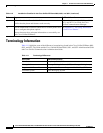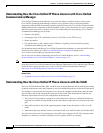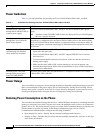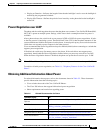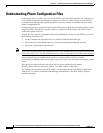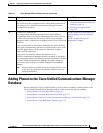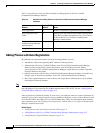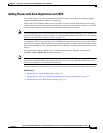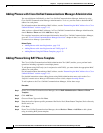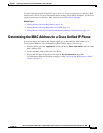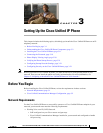
2-8
Cisco Unified IP Phone 8961, 9951, and 9971 Administration Guide for Cisco Unified Communications Manager 8.5 (SIP)
OL-20861-01
Chapter 2 Preparing to Install the Cisco Unified IP Phone on Your Network
Understanding the Phone Startup Process
4. Load the stored phone image.
The Cisco Unified IP Phone has non-volatile Flash memory in which it
stores firmware images and user-defined preferences. At startup, the
phone runs a bootstrap loader that loads a phone image stored in Flash
memory. Using this image, the phone initializes its software and
hardware.
• Resolving Startup Problems,
page 12-1.
5. Configure the VLAN.
If the Cisco Unified IP Phone is connected to a Cisco Catalyst switch,
the switch next informs the phone of the voice VLAN defined on the
switch. The phone needs to know its VLAN membership before it can
proceed with the Dynamic Host Configuration Protocol (DHCP)
request for an IP address.
• Ethernet Setup Menu, page 7-4.
• Resolving Startup Problems,
page 12-1.
6. Obtain an IP address.
If the Cisco Unified IP Phone is using DHCP to obtain an IP address,
the phone queries the DHCP server to obtain one. If you are not using
DHCP in your network, you must assign static IP addresses to each
phone locally.
• Ethernet Setup Menu, page 7-4.
• Resolving Startup Problems,
page 12-1.
7. Requesting the CTL file.
The TFTP server stores the CTL file. This file contains the certificates
necessary for establishing a secure connection between the phone and
Cisco Unified CM.
Refer to Cisco Unified
Communications Manager Security
Guide, Configuring the Cisco CTL
Client.
8. Requesting the ITL file.
The phone requests the ITL file after it requests the CTL file. The ITL
file contains the certificates of the entities that the phone can trust. The
certificates are used for authenticating a secure connection with the
servers or authenticating a digital signature signed by the servers. The
ITL file is supported on the Cisco Unified CM 8.5 and later.
See the “Preparing to Install the Cisco
Unified IP Phone on Your Network”
chapter.
See the “Troubleshooting and
Maintenance” chapter.
9. Access a TFTP server.
In addition to assigning an IP address, the DHCP server directs the
Cisco Unified IP Phone to a TFTP Server. If the phone has a statically
defined IP address, you must configure the TFTP server locally on the
phone; the phone then contacts the TFTP server directly.
Note You can also assign an alternative TFTP server to use instead of
the one assigned by DHCP.
• Ethernet Setup Menu, page 7-4.
• Resolving Startup Problems,
page 12-1.
Table 2-3 Cisco Unified IP Phone Startup Process (continued)
Task Purpose Related Topics



